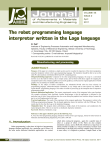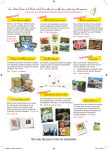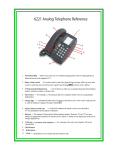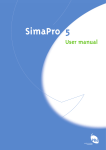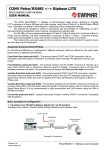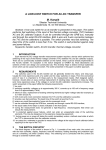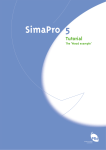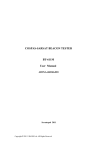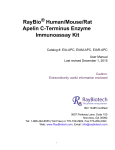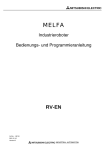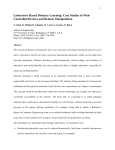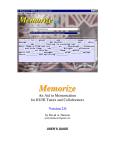Download Remote programming of the Mitsubishi
Transcript
of Achievements in Materials and Manufacturing Engineering VOLUME 31 ISSUE 2 December 2008 Remote programming of the Mitsubishi Movemaster robot by using the web-based interface K. Foit* Institute of Engineering Processes Automation and Integrated Manufacturing Systems, ul. Konarskiego 18a, 44-100 Gliwice, Poland * Corresponding author: E-mail address: [email protected] Received 11.09.2008; published in revised form 01.12.2008 Manufacturing and processing ABSTRACT Purpose: The aim of this paper is to present a prototype of web-based programming interface for the Mitsubishi Movemaster RV-M1 robot. Design/methodology/approach: The web techniques have been selected due to modularity of this solution and possibility of use the existing code fragments for elaborating new applications. The previous papers [11-14] have presented the off-line, remote programming system for the RV-M1 robot. The general idea of this system is a base for developing a web-based programming interface. Findings: The prototype of the system has been developed. Research limitations/implications: The presented system is in the early development stage and there is a lack of some functions. In the future a visualisation module will be elaborated and the trajectory translator intended to co-operate with CAD software will be included. Practical implications: The previous version of the system has been intended for educational purposes. It is planned that new version will be more flexible and it will have the possibility of being adapted for other devices, like small PLC’s or other robots. Originality/value: Remote supervision of machines during a manufacturing process is an actual issue. Most of automation systems manufacturers produce supervising software for their PLC’s and robots. The Movemaster RV-M1 robot is an old model and is lack of the high-tech software. On the other hand, the programming and development of applications for this robot are very easy. The aim of the presented project is to develop a flexible, remote-programming environment. Keywords: Automation engineering processes; Robotics: Mechatronics; Technological devices and equipment; Numerical techniques 1. Introduction 1. Introduction Industrial networks are very significant elements of a contemporary factory. They connect different levels of a company, giving the possibility of analysing and change of production parameters from an office room. The network also connects machines and control systems in order to exchange the data between them. Programs for controllers are often prepared and tested on computers, using a virtual environment, then are uploaded to a real device, using network connections [1-9]. An example of the off-line programming and simulation package has been presented in the papers [11-14]. The software package has been written in a high level, object oriented programming language and it consists of three applications: x SERWER – the server module, x ROBO – the programming and simulation module for RV-M1 robot, © Copyright by International OCSCO World Press. All rights reserved. 2008 Research paper 639 Journal of Achievements in Materials and Manufacturing Engineering x KAMROB – the Internet camera and robot control module. The complete system has been designed to operate with the Mitsubishi Movemaster RV-M1 robot. It uses a typical personal computer equipped with serial port and serial connection between the robot's control unit and the computer. The system is intended and it should be executed on 32-bit Microsoft Windows platform. It also requires the TCP/IP network connection. The package has been intended to run on the Microsoft Windows platform with the use of a network connection. The Mitsubishi Movemaster RV-M1is the robot with a five-axis manipulator and 1.2 kg lifting capacity. The control device of the robot is equipped with the card containing 16 binary inputs and outputs. It has also the possibility of connecting it to a personal computer, using Centronics or RS232 port. Despite the small size of the robot, it is a typical industrial machine. The robot can be programmed using a personal computer or by the teaching box – in case of using the teaching box only positions can be written into memory. In case of using a computer, program is prepared in Movemaster Commands language. It has very simple syntax and allows writing the code in any text editor. The robot can work in “batch mode” when every command is immediately executed after sending it to the robot's controller [15]. Due to properties of the robot’s programming language, allow a user to quickly create its own communication software for co-operation with the robot. The main disadvantages of the software described in [11-14] is that it is intended for the Windows platform only and cannot be easily ported to the other operating system platform. In the publications [10-14] a general concept of a platform independent application has been presented. This paper presents more details of this idea and describes the prototype of the software. Volume 31 Issue 2 December 2008 It is a typical configuration with a server on the one side and a client on the other one. The ROBO application is a client program and it is installed on the user machine. The SERWER and KAMROB applications should be installed on the server computer. There can be one server for both applications or two machines – one for handling the robot and the other for control the Internet camera. The off-line programming and simulation tasks are done by the ROBO application. A simple program can be also generated by using a CAD program (for example in AutoCAD). A path is coded in 3-D by a line entity. Each point represents a position of the robot’s wrist and the status of the gripper (open or closed) is described by a point entity. The trajectory is then saved in the DXF. The ROBO application uses a dictionary file to translate DXF commands into proper Movemaster Commands directives. A control panel and a simulation window are two main areas of the ROBO application’s window (Figure 2). The simulation routine uses the OpenGL libraries and models created in a 3D modelling program to achieve the imitation of a real robot’s environment. There is also possible to add some type of equipment to the virtual environment: besides an object of manipulation, tables and shelves can be added to the robot’s scene. All the 3D data can be edited in the modeller, so the environment and objects could be changed or updated. There is also the possibility of handling more than one virtual robot, but this feature requires at least two copies of the ROBO program connected to the same server. 2. Thedescription description the system 2. The of theof existing existing system and the andconcept the concept the new ofofthe newone one As it was described in the section 1, the existing system consists of three applications: the server module, the programming and simulation module and the Internet camera and robot control module. The Figure 1 shows an example of a hardware configuration, used with the software package. Internet camera Fig. 2. The main window of the ROBO application with two robots in simulation area Client station (ROBO) Server computer (KAMROB, SERWER) RV-M1 robot Fig. 1. The example of a hardware configuration used with ROBO software package 640 Research paper The papers [10-14] describe all advantages of the system details. It should be mentioned that the ROBO system has been developed in collaboration with a student, so it has been primarily intended for educational purposed. The main drawbacks of the system are: x the need of installation on both – server and client side, x the dependence on the Windows operating system. In order to eliminate mentioned disadvantages, an idea of a platform-independent system has been developed. There has been K. Foit Manufacturing and processing one solution based on a web server (Figure 3), and the other based on the Java environment (Figure 4) – both described with all the particulars in the papers [10, 14]. In the further part of this paper, a selected method will be described. Client computer Server computer Robot system NETWORK Web browser with plug-ins Web server, CGI, robot control Fig. 3. The idea of the web-based programming system Client computer Server computer Robot system NETWORK Java Runtime Environment Web server with Java archives Fig. 4. The idea of the Java-based programming system 2.1. The idea of the system 2.1. The idea of the new new system It has been decided that for the further development the method based on a web server will be used. There are some benefits of this method in comparison with the Java-based system: x the source code of previously developed system need not be translated, x in the case that the server will be run on the Windows operating system, the new applications could be created on the base of the existing source code, x the interface of the application is provided by the web resources, so there is no need to develop a graphical user interface for any new application, x the system can achieve a high level of modularity, because applications can be developed as independent modules used “on demand”, x the user interface can be easily modified and developed from scratch to the advanced one, x there is a possibility of using secure connections certificates and distributed services, x there can be alternative user interfaces intended to use on a different operating system and browser platforms, like ActiveX, Flash or Java modules. The first, experimental version of the web-based programming system has not been equipped with 3-D simulation module. This feature will be enabled in further versions. It is planned to use the Adobe Flash, the Shockwave the VRML/X3D plug-in to build simulation interface. The existing version also has not video transmission module. These features have not been important to achieve the basic functionality, so they have been omitted during the development process. On the other hand, they require special modules and software to elaborate them. 3. The preliminary version 3. The preliminary version of webof web-based programming based programming interface interface The preliminary version of web-based programming interface for the Mitsubishi Movemaster RV-M1 robot has been based on a web server running on Windows operating system and CGI (Common Gateway Interface) programs. The CGI allows a web server to interface with external application software. It means that a web server process a request from a web browser, transfer the parameter to an external application and run it. The application returns output information to the server and the server transmits it to the client’s browser. In this manner, any application or script can be called. Fig. 5. The Control Panel page from the web-based programming interface Remote programming of the Mitsubishi Movemaster robot by using the web-based interface 641 Journal of Achievements in Materials and Manufacturing Engineering Volume 31 Issue 2 December 2008 3.1. The interface 3.1. The interface In this section, the web-based interface will be discussed. In order to use the interface a user must log in into service. After logging-in, the main page is displayed in a web browser. The working area consists of two parts: a menu frame on the left side and an operation frame on the right (Figure 5). The menu contains three sections: x Control Panel – it is used to provide basic administration tasks for the control unit of the robot, x Program – this section is related to all the actions connected with robot’s programming, i.e. program upload and download, step by step execution, I/O monitor, x Positions – the section is connected with adding and deleting positions of the manipulator and defining the status of the gripper. The Control Panel menu consists of four commands: x Nest – resets the manipulator to the origin position (zero), x Run – executes a program stored in memory, x Clear program – clears the program area of the controller’s memory, x Clear positions – clears the positions area of the controller’s memory. All the executed operations should be confirmed by the user. This is done by using JavaScript code, which displays a confirmation window. An example of such a window is shown in Figure 6. Fig. 6. An example of a confirmation window shown before operation The Program and Positions menus are intended for robot’s programming and adding or deleting positions. The procedure of programming the robot with use of the web interface is very similar to a classic way, which is conducted by using any dedicated application. In the Figure 7 the complete programming interface is shown. It consists of program editing area, five buttons and log area. The Programming window format is intended for program editing. A user can manually enter a program text or paste it from an external editor. After editing, the code can be copied and inserted to a text editor. The program can be also uploaded from or downloaded to a file. This is done by using Download from robot and Send to robot buttons. A copy of the uploaded or downloaded program is made automatically after selecting one of the mentioned buttons. The upload from a file procedure is conducted if the programming window is empty. Then the small window is displayed, where a user can select a file to upload. Fig. 7. The Programming Panel 642 Research paper K. Foit Manufacturing and processing The Clear robot’s progr. button has the same functionality like the Clear program function in the Control Panel page. The Step by step exec. button is intended for a program testing. It sends a program to the controller without line numbers, line by line, which causes the immediate execution of a sent command. The Log window displays current robot status. Besides of error messages it displays also the result of last executed command. The Clear window button, located under the window, clears all the messages. The messages and programming window will be cleared after leaving the Programming Panel and returning to it later. It is required to execute the Download or Send functions in case the programming window to be filled every time the Programming Panel is loaded. This issue will be overworked in the further versions of the interface. The last menu item is the Positions Panel (Fig. 8). This section is responsible for definition and manipulation of the positions data set. The panel contains one editing window, where a user can enter a PD or PC commands sequence. There are three buttons under the window, which are responsible for communication with the robot’s control unit. The buttons marked as Download from robot, Send to robot and Clear robot’s pos. have similar functions as in case of Programming Panel. A file saving and uploading is done in the same way as in the Programming Panel with the only a little difference, that the positions are stored and uploaded without line numbers, so the directives are executed on the fly. The nesting procedure is executed automatically before sending any data. The coordinates can be also entered using the Coordinates panel section. There are six fields for entering numbers. The Pos. nr field is for writing the position number, the X, Y and Z are responsible for coordinates. Finally, the Pitch and Roll describe the position of the wrist. After entering the numbers, one can use the Define position button for the automatic generation of the PD command, which is finally added to the editor window. In order to use the HERE and P. Clear buttons require defining a position number only. The first button defines a position on the base on the current location of the manipulator. The definition is automatically added to the editor window. This is useful in case of moving the manipulator using incremental functions, when the concrete position should be defined. The P. Clear button generates the PC commands and erases the definition specified by the position number from the controller’s memory. As opposed to the HERE and Define position buttons, the PC command is executed immediately, without inserting it to the editor window. The last part of the Positions Panel is a section that contains the position check buttons. There are three buttons: x INC o – moves the manipulator to the next position on the position list, x m DEC – moves the manipulator to the previous position on the position list, x Go to position – moves the manipulator to the position number entered into the text field; if the position does not exist on the list then an error message is displayed. Fig. 8. The Positions Panel Remote programming of the Mitsubishi Movemaster robot by using the web-based interface 643 Journal of Achievements in Materials and Manufacturing Engineering The presented web-based programming interface consists only the most frequently used functions. It should assure only the basic functionality, which is necessary to test an application. Before executing the Run command or sending the position data to the manipulator, the Nest command is automatically called. This is a security issue to assure that before any move is done, the manipulator always starts from the same position. 3.2. The communication 3.2. The communication Processing layer Communication layer As it was mentioned earlier, the model based on the web server and CGI has been selected to prepare the interface. The assumption of this method is that every form is connected with some action on the server side. The core application is the web server, which processes requests from a client browser and intermediates between the client side and applications. Some of the code is also executed on the client side, mainly the scripts processed by browser. It provides a better functionality and maintenance of the forms. There are several applications on the server side, which are executed by the CGI action requests. In this case, the modularity means the better functionality, because there is no need to rebuild one, huge application – the small application code is better to understand and for further processing and enhancement. It is also the best method to avoid errors during the exploitation of the system. The applications, which are executed on the server, can be generally divided into three groups: x the applications providing the communication between the server computer and the robot’s controller, x the applications for processing the operation results obtained from the programs belonging to the group mentioned above and for generating the appreciate reports in the HTML code, Volume 31 Issue 2 December 2008 x the applications providing the maintenance tasks, which are not directly connected with the communication issues, but can be used by any application belonging to any group mentioned above. It is obvious that modularity means also the lower workload of the overall server system. The applications are loaded on demand. This may cause some delays, but they are not important from the user’s point of view, because this is not a real-time system. The communication process is schematically shown in Figure 9. The web server application receives a request from a browser and redirects it by CGI interface to a proper application. The application processes the information and uses the communication program to send it to the robot’s controller. The communication application requests the status of the robot or receives the data, which are redirected to the other program in order to generate HTML output. The HTML file is then processed by web server application and sent by network to the browser. The maintenance applications are independent programs, which do not participate directly in the communication process. The role of these applications is to do some marginal tasks like setting the serial communication parameters, checking the syntax, doing characters conversion, etc. These applications are used by the other, belonging to the first two layers of the system and by the web server module. Besides mentioned software installed on the server there is some more, like script interpreters, database server or preloaded modules for browsers: plugins, ActiveX, Java applications. At this stage of development, there is no need to install all of them. Some actions are realised as scripts, so they need an interpreter, but the main modules are compiled. The experimental server system is running on the Windows platform. This operation system has been selected because existing source code has been written for the Delphi compiler and thus some element of it can be used in the new, web-based system. CGI Server Web browser Maintenance Fig. 9. The schema of the communication process 644 Research paper K. Foit Manufacturing and processing 4. Conclusions 4. Conclusions The main aim of this work was to elaborate a web-based system for programming the Mitsubishi Movemaster RV-M1 robot. This system has been assumed as a platform independent, so it should be compatible with most available web browsers and should not use system-dependent modules on the client side. The other assumption has been made that the first version should assure only the basic functionality needed for system testing. The emphasis has been put on the development of the server side software. 4.1. The overall rating the project 4.1. The overall rating of theofproject Hardware requirements. Because of using the modular structure of the software installed on the server, the system is not overloaded by time consuming or memory consuming tasks. The use of simple and lightweight web server software has minimized the workload of the system. The server has run quite smoothly on Windows 98 operating system (without any other unnecessary applications), using Pentium I 200MHz based mainboard and 1GB hard disk. The client side hardware requirements are connected with used operating system and a web browser application. Performance. Because the system is not intended to be real-time, then the performance is not a priority. The overall performance is quite well, short delays are the result of sending commands over the network. They are the most noticeable during the “step by step” execution of a program or during use of the position checking function in Positions Panel. The delays are also the result of using the serial communication between the server and the robot. Compatibility. The system has been tested on the most popular web browsers running on the different operating system platform – no problem has been noticed. Some changes in the appearance of the page have been caused by the browsers’ rendering engines. Operation of the system. A web interface is friendlier than any other. This is also because a web browser is the most used application by computer users. Of course, the operation of the web-based programming system for the RV-M1 robot requires at least basic knowledge of Movemaster Command language and about operating the robot. Functionality. The experimental version of the system has limited functionality because being at testing stage. 4.2. The future plans 4.2. The future plans In the future it is planned to elaborate more functional interface for the system. The other proposals are: x the Linux/FreeBSD implementation in order to use the free, fully configurable operating system, x the implementation of simulation window with the virtual workspace, x the introduction of some elements of visual programming, x the implementation of the DXF converter [10-14] for trajectory generation, x the elaboration of an ActiveX control or DDE server for use with different Windows applications. There is also an idea of using a similar system for PLC controllers. Such a system should be more advanced to implement the standard PLC’s programming languages. References References [1] [2] [3] [4] [5] [6] [7] [8] [9] [10] [11] [12] [13] [14] [15] T. OtrĊbski, Remote monitoring and control using GPRS service, Control Engineering Poland 8/36 (2006) 62-64 (in Polish). A. Presher, The network control of machines – in the spotlight, Design News 9/16 (2006) 48-51 (in Polish). S.F. Chan, R. Kwan, Post-processing methodologies for offline robot programming within computer integrated manufacture, Journal of Materials Processing Technology 139 (2003) 8-14. G. Yasuda, Distributed autonomous control of modular robot systems using parallel programming, Journal of Materials Processing Technology 141 (2003) 357-364. G. Kost, R. Zdanowicz, Modeling of manufacturing systems and robot motions, Journal of Materials Processing Technology 164-165 (2005) 1369-1378. J. Alvares, J.C. Espindola Ferreira, WebTurning: Teleoperation of a CNC turning center through the Internet, Journal of Materials Processing Technology 179 (2006) 251-259. T.S. Mujber, T. Szecsi, M.S.J. Hashmi, Virtual reality applications in manufacturing process simulation, Journal of Materials Processing Technology 155-156 (2004) 1834-1838. Q. Peng, F.R. Hall, P.M. Lister, Application and evaluation of VR-based CAPP system, Journal of Materials Processing Technology 107 (2000) 153-159. W.B. Lee, C.F Cheung, J.G Li, Applications of virtual manufacturing in materials processing, Journal of Materials Processing Technology 113 (2001) 416-423. K. Foit, J. ĝwider, The project of a platform-independent, offline programming system for industrial robots. Proceedings of the 7th International Scientific Conference “Computer Integrated Manufacturing - Intelligent Manufacturing Systems” CIM'2005, GliwiceíWisáa, 2005, 62-65. K. Foit, J. ĝwider, D. Mastrowski, The project of an off-line, remote programming system for Mitsubishi Movemaster industrial robot, Proceedings of the 13th International Scientific and Technical Conference “Machine-Building and Technosphere of the XXI”, Sevastopol, 2006, vol. 4, 252-255. D. Mastrowski, The system for remote programming, supervision and simulation of robots, cooperating with Mitsubishi Movemaster RV-M1 Robot, MSc thesis, Gliwice, 2006 (in Polish). J. ĝwider, K. Foit, G. Wszoáek, D. Mastrowski, The off-line programming and simulation software for the Mitsubishi Movemaster RV-M1 robot, Journal of Achievements in Materials and Manufacturing Engineering 20 (2007) 499-502. J. ĝwider, K. Foit, G. Wszoáek, D. Mastrowski, The system for simulation and offline, remote programming of the Mitsubishi Movemaster RV-M1 robot, Journal of Achievements in Materials and Manufacturing Engineering 25/1 (2007) 7-14. Mitsubishi Movemaster RV-M1 User’s Manual. READING DIRECT: www.journalamme.org 645







